Most branches of technology have a certain number of
jargon terms associated with them. New terms may appear over time as the
technology evolves. Old terms fall into disuse. If you are just
starting to explore the early history of internal combustion engines, this list
of jargon terms and definitions should help you become familiar with some of the
fascinating and prominent features of early engines. Note that a number of
these features, refined and repackaged, are still in use on modern
engines.
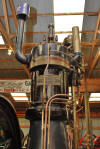 |
Air Injection Engine - Also known
as an air-blast injection engine. A engine
that uses high pressure air to inject liquid fuel directly into the
cylinder near the peak of the compression stroke. The fuel ignites
as it encounters the hot, compressed air in the cylinder. Air
pressure as high as 1000 psi is often necessary to operate this type of
fuel injection system. A number of early diesel engines used this
system of fuel injection before solid injection technology was developed to directly
pressurize, inject, and atomize liquid fuel. |
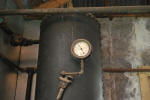 |
Air Starting
- A method of starting an engine by injecting compressed air into the
cylinder(s) to initially roll the engine. The timing and flow of
compressed air may be controlled manually or mechanically. Air
starting is particularly useful for engines that are too large to be
easily or safely started by hand. |
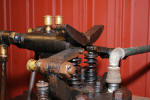 |
Alligator Linkage - A cam and
follower arrangement where the cam pivots at one end and the lobe near
the opposite end of the cam contacts and moves a follower. |
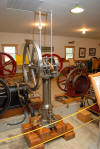 |
Atmospheric Engine - An engine
that does not compress the fuel-air mixture prior to ignition. The
initiation of combustion occurs at, or near, atmospheric pressure.
Also known as a non-compressing engine. |
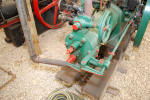 |
Atmospheric Intake - An intake
valve operated by the difference between atmospheric pressure and
cylinder pressure. The intake valve stem and spring are shown
above the power operated exhaust valve in this photo.
Also known as an automatic intake. |
 |
Bar Over - To manually turn an
engine over using a lever. In some designs the lever is inserted
directly into pockets in the face of the flywheel rim. In other
designs, as shown in the photo, the lever operates a ratchet mechanism
that engages pockets in the face of the flywheel rim. |
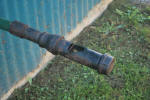 |
Barker - A device installed on an
engine's exhaust pipe to alter the sound of the exhaust pulses. Barkers
were used in oil field installations where a number of similar engines
were located some distance apart and were perhaps obscured by trees and
underbrush. By giving the engines unique exhaust sounds, the field
engineer could more easily recognize the sounds of individual engines
and could monitor their operation from a distance by sound rather than by
sight. Barkers varied in design and were often made from whatever
materials were available - along with a bit of ingenuity. |
 |
Camstopper -
A means of hit and miss engine speed governing
where the camshaft or side shaft stops rotation, thus stopping valve action
and fuel
induction to prevent the engine from producing
power cycles. Also see
declutching
sideshaft. |
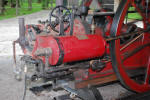 |
Charging Cylinder - A cylinder
and piston, separate from the engine's power cylinder, used to force air,
or fuel and air mixture, into the engine's power cylinder. |
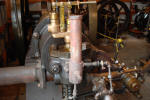 |
Chimney - The
device that surrounds and heats a
hot tube. A
chimney typically has a burner at its base. The burner, shown entering the
chimney from the right in this
photo, creates a hot spot on the tube. Some designs of chimney are adjustable so that the location of
the hot spot on the tube may be changed to adjust ignition timing.
Placing the hot spot further from the cylinder retards ignition.
Placing the hot spot closer to the cylinder advances ignition.
Also known as a furnace. |
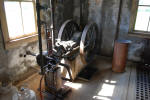 |
Compressor Engine - An engine that includes a means for
compressing gas (often air) as an integral part of its overall
structure. Some compressor engines contain both a power piston and
a compressor piston operating in tandem in the same cylinder. |
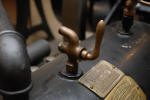 |
Compression Release - A device
for allowing a portion of the compressed air and fuel mixture in the engine's
cylinder to escape, lowering compression and allowing the engine to be
rolled more easily for starting. Compression releases may hold an
intake or exhaust valve open. Another type of release consists of
a hand-operated valve on the cylinder, as shown in the photo. Depending upon
their design, compression releases are automatically or manually
deactivated once the engine is running. |
 |
Convertible Engine - An engine
that can be run either as a steam engine or as an internal combustion
engine. Some half breed
engines include convertible operation. |
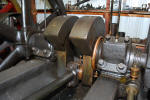 |
Counterbalanced Crankshaft - A
crankshaft with balance weights installed opposite the crank pin.
The balance weights help to offset the weight of the piston and
connecting rod resulting in smoother operation. |
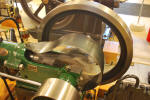 |
Crank Fender - A shield placed
around the crankshaft to contain oil droplets thrown by the moving
crankshaft and connecting rod. |
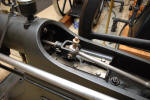 |
Cross Head - A sliding bearing
that supports the piston rod and carries the wrist pin attachment point
for the connecting rod. A cross head allows the piston rod to move
in a straight line and reduces side loads on the piston. In some
applications it allows the cylinder end and piston rod to be sealed so
that the area behind the piston may be used for compressing gas or may
be used for combustion in a double-acting cylinder. |
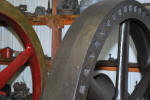 |
Crowned Flywheel - A flywheel
with the diameter slightly larger in the center of the rim than at the
edges of the rim. The raised center of the flywheel helps to
stabilize and position a flat belt running on the face of the flywheel
rim. |
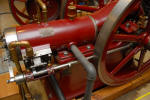 |
Declutching Side Shaft - A means of
Hit and Miss engine
speed governing where the side shaft stops rotation to prevent the engine
from producing power cycles. Also see
camstopper. |
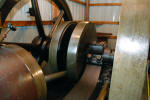 |
Disc Crank - A form of crank
assembly where the crank pin is mounted between a pair of discs. The discs are
attached to the "half" sections of the crank shaft. |
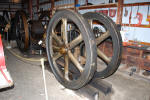 |
Electric Lighting Engine - An
engine with exceptionally heavy flywheels, sometimes lead-filled, designed to provide minimal
speed variation between power cycles when driving a generator.
Minimizing speed variations reduces flickering of lights powered by the
generator. |
 |
English Style Exhaust Valve Spring
- A spring in tension that holds the exhaust valve closed. The
spring is located away from the hot portions of the engine to
avoid thermal damage to the spring. |
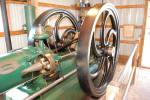 |
English Style Flywheel - A
flywheel cast with curved spokes. Many engines built in England
featured this design. The curved spoke design was believed to
result in a higher success rate in producing flywheel castings. |
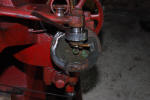 |
Face Cam - A type of cam that
has the lobe machined on the front face of a disk. The follower
rides the face of the disk to engage the cam lobe. |
 |
Flyball Governor - A
speed regulation device that uses a set of flyweights to actuate
linkages that control engine speed. The governor may regulate
speed by modulating the intake of fuel and/or air or it may regulate
speed by controlling combustion hit and miss. |
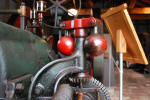 |
Flyweights - A set of pivoted
masses mounted to a governor shaft that move in proportion to the speed of the
shaft. The flyweights swing away from the shaft as speed
increases. They swing toward the shaft as speed decreases. |
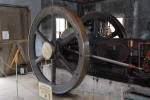 |
Flywheel - An energy storage
device that provides power for induction, for compression, for exhaust, and for
operating the engine's load between power cycles. The engine
accelerates and "charges" the flywheel during the power cycle. The
flywheel decelerates and "discharges" as it provides power during the
other cycles. |
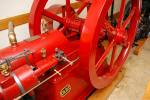 |
Gearless Engine - An engine that
mechanically operates the intake and exhaust valves, ignition, and fuel
supply without the use of gear-driven mechanisms. |
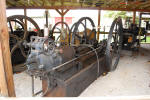 |
Half Breed Engine - A steam
engine that was converted to internal combustion operation by
replacing the cylinder and other parts while retaining the main frame,
flywheels and the bulk of the engine. Manufacturers often
produced kits of parts for the conversion. |
 |
High Tension Ignition - An
ignition system that uses high voltage to create a spark across a fixed
air
gap in the cylinder. |
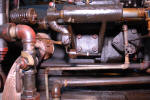 |
Hit and Miss Governing (Also
Hit or Miss Governing) - A form of engine speed
regulation where power cycles are permitted ("hits") or prohibited
("misses") to maintain speed within the governed range. The energy
released in each power cycle is relatively constant regardless of engine
load. When lightly
loaded, the engine may miss many power cycles before hitting to recover
speed. The small
pendulum governor in the photo interrupts the
introduction of fuel to this engine to regulate speed. |
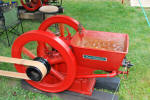 |
Hopper Cooling - A form
of evaporative cooling system where the engine cylinder is surrounded by
an open-topped chamber that is filled with water. As water
evaporates it escapes into the atmosphere carrying away heat.
The operator of the engine periodically replenishes the supply of water. |
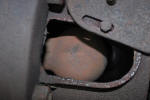 |
Hot Bulb - A form of
vaporizer using a lightbulb-shaped chamber
attached to the cylinder. The hot bulb is heated by an external
burner for starting and for low load operation. At higher loads
the combustion occuring within the hot bulb maintains its temperature. |
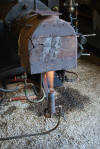 |
Hot Start Engine - An engine that
requires an external heat source, such as a burner or torch, to
initially raise the temperature of components, usually the engine's
vaporizer, to a point sufficient for starting. |
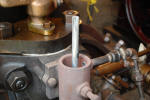 |
Hot Tube -
A form of ignition system that uses an externally heated tube that opens
into the combustion chamber. The tube is sealed on the opposite end.
Hot tubes are typically mounted in a
chimney heated by a
burner. In this photo the upper portion of the chimney is removed to show
the hot tube. The burner enters this chimney from the right in the
photo. The burner creates a hot spot on the tube. Fuel and
air mixture enters the tube as the
piston nears the top of the compression stroke. Combustion begins in the tube at the hot spot and
travels out of the tube and into the cylinder. |
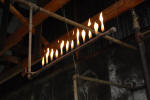 |
Illuminating Gas - A flammable
gas produced from coal. Illuminating gas
contains hydrogen as well as carbon monoxide. It was originally
produced as fuel for gas lamps but also found use as fuel for internal
combustion engines. Also known as town gas or
coal gas. |
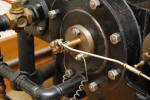 |
Low Tension Ignition - An
ignition system that uses low voltage, often supplied by a battery, to
create a spark in the combustion chamber. Low tension ignition
often involves some form of
make and break mechanism. |
 |
Lubricator - A device for
applying a regulated amount of oil to engine bearings and other moving
parts. Lubricators are made in many different designs, some
providing gravity feed, others providing mechanical feed. |
 |
Magneto - An electrical generator
that uses permanant magnets to provide a magnetic field.
Electricity is produced when a coil of wire moves in the magnetic
field of stationary magnets or when magnets move past a stationary coil
of wire. Some types of magneto can produce high voltages for
high tension ignition systems. |
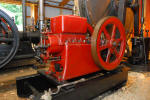 |
Main Frame - The casting or
weldment that forms the base of the engine. The cylinder,
crankshaft and other engine parts are mounted on the main frame.
The main frame may be fastened to a floor or other structure to secure
the engine. |
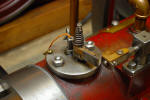 |
Make and Break Igniter -
A form of low tension ignition system where a pair of contacts, at least
one of which is movable, are placed in the engine's cylinder. When
the contacts are closed, electric current flows through the contacts. When opened,
a spark occurs and ignites the fuel and air mixture in the cylinder. |
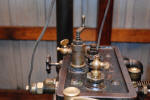 |
Match Starter - A form of
engine starting device that uses a "kitchen" match to provide first
ignition. A match is inserted into the starter and the starter is closed
to prevent loss of compression. The match is exposed to the fuel
and air mixture in the cylinder. The engine is turned back on
compression and the starter is then operated to strike the match.
The match lights and ignites the compressed fuel and air mixture in the
cylinder producing the first power cycle and rolling the engine. |
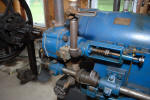 |
Mixer - A device for metering
fuel into air to produce a fuel and air mixture for induction into an
engine's cylinder(s). |
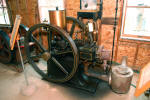 |
Oil Engine - A type of engine
designed to use kerosene or heavier oil as fuel. Oil engines use
compression ignition but do not have a compression ratio high enough to
directly ignite the fuel. Instead, they generally use some form of
vaporizer to
preheat and prepare the fuel for ignition. |
 |
Open Flame Ignition - A form of
ignition system that introduces an externally-produced flame into the
fuel and air mixture in the cylinder. The flame may be drawn into
the cylinder from an external burner or it may be carried into the
cylinder by a slide valve arrangement. |
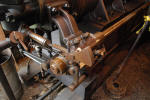 |
Pendulum Governor - A speed
regulation device that uses a swinging pendulum set in motion by the
engine to actuate linkages that control engine speed. This type of governor
typically controls combustion hit and miss. |
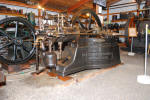 |
Piano Base (also Grand
Piano Base) - A feature of early Crossley engines where the
main frame beneath the crankshaft was much wider than the main frame
beneath the cylinder. The rounded form of the main frame bears a resemblance to a piano. |
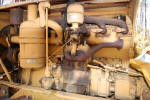 |
Pony Engine - A small engine used
to start a large engine. Although it adds mechanical complexity, the
pony engine (sometimes called a pony motor) eliminates the need for a bulky air starting system or a
large electric starter and heavy batteries. The pony engine itself may
be hand started or may be started with a small electric motor and
modest-sized battery. In some installations, the pony engine may
be used to preheat coolant and intake air for the large engine, helping
to ease starting of the large engine. |
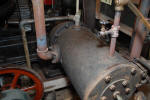 |
Ported Cylinder - An arrangement
for providing an exhaust path from a cylinder via a hole in the cylinder
wall. In some designs, the ported exhaust provides the initial
exhaust path with the piston near the bottom of the power stroke.
An exhaust valve then provides the subsequent exhaust path as the piston
moves through the exhaust stroke. The port reduces the heat load
on the exhaust valve, extending its service life. |
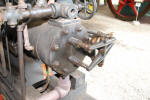 |
Power Operated Valves - Intake
and/or exhaust valves that are operated by a mechanical linkage. |
 |
Priming Cup - A means for
introducing fuel directly into the cylinder prior to starting. The
extra fuel provides a richer fuel/air mixture and improves starting
reliability. |
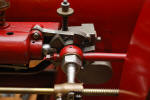 |
Ratchet Wheel - A type of cam
that features high and low lobes arranged in a circle. Rotating the
ratchet wheel a fraction of a turn positions either a high lobe or a low
lobe to operate linkages or equipment. Ratchet wheels were sometimes
used in gearless engine designs to provide "every other revolution"
actuation for engine components such as valves, ignition, and fuel
supply. |
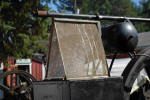 |
Screen Cooling - A form of
evaporative cooling system where water warmed by an engine is pumped
over a screen. The screen breaks the flow of water into smaller
droplets to increase the surface area available for convective and
evaporative heat
transfer. Water collected below the screen is returned to the
engine. The engine's operator periodically replenishes the supply
of water to make up for evaporation. |
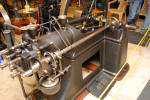 |
Side Shaft -
A shaft mounted along the cylinder and main frame and used to drive
valve gear as well as other engine accessories at the back of the engine. The side shaft is
usually gear driven from the crankshaft and runs at 1/2 engine speed on
four-cycle engines. |
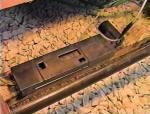 |
Slide Valve - An early form of
open flame ignition device consisting of a slide with a pocket for
carrying a small quantity of burning gas, ignited at atmospheric pressure, to
the compressed fuel and air mixture in the cylinder. Some slides
include bleed grooves that allow mixture being compressed in the
cylinder to flow into the pocket to feed and maintain the flame prior to
the pocket being exposed to the cylinder. The slide shown
here has been removed from the engine for clarity. |
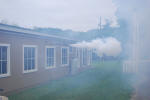 |
Stack Music - The unique sound
produced by an engine's exhaust. |
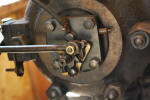 |
Star Wheel Igniter - A
low tension ignition device that
uses a rotating contact assembly driven by a toothed wheel and a ratchet
mechanism that turns the wheel. |
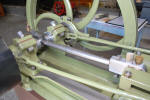 |
Tapered Connecting Rod - A
connecting rod machined with a varying cross section, thicker in the
middle and thinner at both ends. |
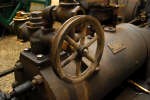 |
Telegraph Wheel - A wheel used
to adjust the fuel flow to an engine and to provide remote control of
the engine. When drilling or servicing a well, a wire was wrapped
around this wheel and another like it back on the rig floor. The rig's
wheel was often fastened to the "headache post," a vertical beam under
the rig's walking beam that kept it from crashing down onto the driller
in case the rig's pitman arm came loose. The headache post was close to
the driller making it convenient for him to reach and operate the rig's
wheel to remotely turn the telegraph wheel on the engine. The engine clutch,
frequently a reversing one, had a long rod back to the same location
that gave the driller complete engine control from his position on the
rig floor. |
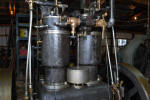 |
Throttle Governing - A form of
engine speed regulation where the energy released in each power cycle is
controlled by modulating the flow of fuel, or fuel and air, into the
cylinder. Power cycles in throttle governing occur regularly
regardless of engine load. |
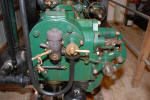 |
Timed Hot Tube - An improved
version of a hot tube that has a valve between
the cylinder and the tube. The valve determines when fuel and air
mixture from the cylinder flows into the hot tube and provides more
precise ignition timing than a simple hot tube. In this example, a
cam driven by the engine side shaft operates the valve. |
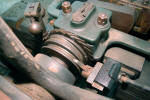 |
Wigwag Cam - A form of
cylindrical cam that has a groove cut in it so that a follower running
in the groove will travel across the width of the cam as the cam turns.
Wigwag cams are often designed such that 2 revolutions of the cam are
necessary to produce one full back-and-forth motion of the follower
across the cam to actuate valve gear on four-cycle engines.
Also known as a crossover cam. |
 |
Wipe Spark Igniter - A form of
low voltage make and break igniter where a moving contact travels past and "wipes"
against a stationary contact. A spark occurs when the moving
contact breaks away from the stationary contact. |
 |
Valve Chest - A chamber attached
to the cylinder that holds the intake and/or exhaust valves for the
cylinder. A port in the valve chest provides the flowpath to the
cylinder. In some designs, ignition occurs in the valve chest and
travels through the port and into the cylinder. |
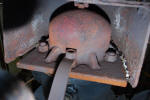 |
Vaporizer -
A chamber attached to and open to the cylinder that is used to evaporate and heat
heavier
fuels prior to ignition. A vaporizer typically operates without
cooling so that combustion occurring within the vaporizer maintains its
temperature. Vaporizers are often equipped with burners or torches
to provide heating for starting and low load operation.
|
Many horizontal engines share a similar arrangement and use a common set of
terminology for describing the arrangement.